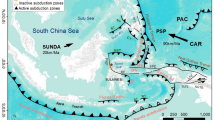Abstract
A source model was discussed for a small tsunami accompanied by the Noto-Hanto-Oki earthquake (M s 6.6), striking Japan on 7 February, 1994. Assuming a fault model under the sea bottom, we estimated the focal parameters jointly, using synthesized tsunami source spectra as well as the tsunami numerical simulation. The fault proposed by this study consists of a plane sized 15×15 km, dipping N47°W with the dip angle of 42°, which is almost pure reverse fault (slip angle 87°) with a dislocation of 1 meter. The numerical simulation shows that the shallow sea in the source region caused a comparatively long recurring tsunami (the periods are 12–18 minutes) in spite of its small size. The model fault is corresponding to an aftershock area of this earthquake.
Similar content being viewed by others
References
Abe, Ku. (1993),Tsunami spectrum as a synthesis of source spectrum and shelf response. In Proceeding of the IUGG/IOC International Tsunami Symposium, pp. 151–163.
Abe, Ku., andIshii, H. (1980),Propagation of Tsunami on a Linear Slope between Two Flat Regions. Part II Reflection and Transmission, J. Phys. Earth28, 543–552.
Aida, I. (1978),Reliability of a Tsunami Source Model Derived from Fault Parameters J. Phys. Earth.26, 57–73.
Hashimoto, T., Ishikawa, Y., andUhira, J. (1993)The 1993 Noto-Honto-Oki Earthquake and its Tectonic Implication (Part 1): A Rupture Process, 1993 Joint Conference of Seismology in East Asia, Proceedings,142.
Imamura, F., Shuto, N., andGoto, C. (1990),Study on Numerical Simulation of the Transoceanic Propagation of Tsunami. Part 2: Characteristics of Tsunami Propagating over the Pacific Ocean, Zisin2 (43), 389–402 (in Japanese).
Masui, T., Takemura, M., andKamata, M. (1994),Simulation of Strong Ground Motion during the 1993 Noto-Hanto-Oki earthquake by a Semi-Empirical Method. Zisin, 2 (47), 375–382 (in Japanese).
Mansinha, L., andSmylie, D. E. (1971),The Displacement Fields of Inclined Faults, Bull. Seismol. Soc. Am.61, 1433–1440.
Matsuura, M., andSato, R. (1975),Displacement Fields due to the Faults, Zisin2 (28), 429–434 (in Japanese).
Satake, K., Okada, M., andAbe, Ku. (1988),Tide Gauge Response to Tsunamis: Measurements at 40 Tide Gauge Stations in Japan, J. Marine Res.46, 557–571.
Yamashita, T. andSato, R. (1980),Geneartion of Tsunami by a Fault Model, J. Phys. Earth22, 415–440.
Author information
Authors and Affiliations
Rights and permissions
About this article
Cite this article
Abe, K., Okada, M. Source model of Noto-Hanto-Oki earthquake tsunami of 7 February 1993. PAGEOPH 144, 621–631 (1995). https://doi.org/10.1007/BF00874386
Received:
Revised:
Accepted:
Issue Date:
DOI: https://doi.org/10.1007/BF00874386




